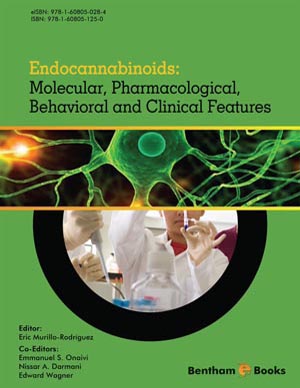Abstract
Research in the last decade has well established that Δ9-THC and related synthetic direct-acting cannabinoid CB1/2 receptor agonists (such as WIN55,212-2, CP55,940) possess broad-spectrum antiemetic efficacy against diverse emetogens via activation of CB1 receptors. We now extend the antiemetic efficacy of these CB1/2 agonists against 20-hydroxyPGE2 and arachidonoyl-2-chloroethylamide (ACEA). Increasing evidence in more recent years also suggests that chronic use of large doses of Δ9-THC in humans can induce intractable vomiting referred to as the cannabinoid hyperemesis syndrome. This chapter discusses the antiemetic/proemetic potential of endocannabinoids such as anandamide, virodhamine, NADA and 2-AG as well as that of synthetic indirectacting cannabimimetic agents that increase endogenous endocannabinoid tissue levels either by inhibiting their metabolism {such as FAAH and MAGL inhibitors (e.g. AA-5- HT/URB597 and JZL184, respectively)} or by blocking their reuptake (e.g. OMDM1, VDM11, AM404). To date published findings indicate that exogenous administration of either 2-AG or anandamide can lead to both antiemetic and proemetic effects depending upon the laboratory conditions used and/or the emetic models utilized. Furthermore, lack of full dose-response studies in most emesis models further confounds a firm conclusion. Likewise, available data indicate that the well-studied FAAH inhibitor URB597 and the above reuptake blockers can prevent vomiting induced by some but not all tested emetogens, and at large doses they can be emetic by themselves. It appears that while the antiemetic efficacy of exogenously-administered endocannabinoids (as well as that of drugs that increase their endogenous levels) is due to activation of CB1- or CB1/TRPV1- receptors, e.g. 2-AG or anandamide, respectively, their emetic potential reside in their tendency to be rapidly metabolized to the proemetic agent arachidonic acid and its downstream emetic metabolites such as prostaglandins (e.g. PGE2, 20-hydroxyPGE2 and PGF2α), leukotrienes (e.g. LTC4 and LTD4) and/or 20-HETE. In fact some analogs of anandamide such as ACEA (a selective CB1 agonist) that are more rapidly metabolized are proemetic, while its more stable congeners (methanandamide or ACPA) lack emetic activity. Thus, exogenously-administered endocannabinoids and drugs that enhance their tissue levels can be antiemetic under certain conditions but unlike Δ9-THC they generally lack broad-spectrum antiemetic efficacy.
Keywords: Emesis, cannabinoids, Δ99-THC, virodhamine, ACEA, CP55, 940, WIN55, 212-2, Prostaglandin F2αProstaglandin E2, 20-hydroxy- prostaglandin E2, Prostaglandin G2, 20-HETE, Area postrema, nucleus tractus solitarius.






















